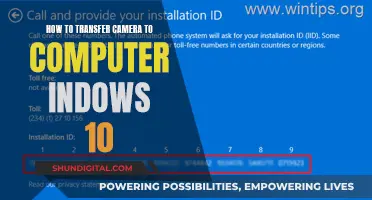
OctoPrint is a tool that can be used to manage 3D printers, record timelapses, and monitor them remotely. Users can also set up a webcam to stream footage in real-time and create timelapses. However, some users have reported issues with the autofocus feature of certain webcams, such as the Logitech C920, where the algorithm chooses the wrong focal point. To address this, users can manually adjust the camera focus by disabling autofocus and setting a fixed autofocus point. This can be done by using commands such as v4l2-ctl -c focus_auto=0 to turn off autofocus and then experimenting with different focus values to find the optimal setting.
What You'll Learn

Disabling autofocus
First, ensure you have the correct software installed. In the case of OctoPrint, this can be done by installing the "Camera Settings" plugin, or by using a script or add-on that runs on boot, such as uvcdynctrl. You can install uvcdynctrl by running the following command:
Sudo apt-get install uvcdynctrl
Next, turn off autofocus by running one of the following commands:
Uvcdynctrl -s "Focus, Auto" 0
Or
V4l2-ctl -c focus_auto=0
The first command uses uvcdynctrl, while the second command is specific to the v4l2-ctl tool. Both will disable autofocus on your camera.
Now that autofocus is disabled, you can manually adjust the focus to your desired setting. To do this, use one of the following commands:
Uvcdynctrl -s 'Focus (absolute)' 122
Or
V4l2-ctl --set-ctrl=focus_absolute=32
The first command sets the focus to a value of 122, while the second command sets it to 32. You can adjust these values as needed to get the desired focus.
Finally, to make these settings permanent, you need to edit the startup file for your streaming software. For OctoPrint, this is usually the mjpg-streamer startup file, which can be found at /home/pi/mjpg-streamer/start.sh. Add the commands you used to set your focus values to the top of this file, save it, and your settings will be applied every time your streaming software starts up.
Turn Off the Camera Square: Quick Tips
You may want to see also

Manual configuration
To manually configure your camera's focus settings on Octopi, you can follow these steps:
First, access your OctoPrint instance via SSH. This will allow you to execute commands to adjust the focus settings. Turn off auto-exposure by running the following command:
V4l2-ctl -c exposure_auto=1
With auto-exposure turned off, you can now adjust the exposure value to suit your lighting conditions and setup. A good starting point is around 600, but this may vary depending on your specific setup. You can fine-tune this value by incrementing or decrementing by 100 until you achieve the desired image quality. Use the following command to set the exposure value:
V4l2-ctl -c exposure_absolute=600
Now that the exposure is adjusted, it's time to move on to the focus settings. If your camera is constantly hunting for focus, resulting in blurry images, it's best to disable auto-focus. You can do this by running the following command:
V4l2-ctl -c focus_auto=0
With auto-focus disabled, you can now manually adjust the focus value. Start with a low value, such as 1, and gradually increase it until you find the sweet spot. If you're not seeing significant differences between values, try increasing by 5 each time, and then fine-tune as needed. Use the following command to set the focus value:
V4l2-ctl -c focus_absolute=1
Once you've found the ideal settings for exposure and focus, you'll want to make these settings persistent. By default, these adjustments will not be saved if you reboot your OctoPrint Pi. To do this, you'll need to edit a configuration file. Open the /home/pi/mjpg-streamer/start.sh file using your preferred text editor. Add the following lines to the file, replacing the values with your chosen settings:
V4l2-ctl -c exposure_auto=1
V4l2-ctl -c exposure_absolute=600
V4l2-ctl -c focus_auto=0
V4l2-ctl -c focus_absolute=2
Save and close the file. Now, whenever the OctoPrint service starts up, your custom camera settings will be applied, ensuring a clear and focused image for your 3D printing projects.
The Highest-Resolution Cameras: Pushing Pixel Boundaries
You may want to see also

Using a plugin
OctoPrint users seeking to adjust their camera focus have a few plugin options to consider.
One plugin that has been mentioned by multiple sources is Octolapse. Octolapse has been described as having "similar functionality (and a GUI!) built right in". It allows users to change a lot of settings, including exposure and gain, white balance, and focus, and these changes are global and stick even after a reboot. The pre-release (v0.4+) has much better camera control support, including apply settings at reboot, sliders, custom control pages (920 is specifically supported with a custom page), and a live stream view of changes.
Another plugin that can be used is OctoPrint-CameraSettings. This plugin allows users to interactively change camera settings by running v4l2-ctl on the backend. This method should work for any Linux environment, including OctoPi, as long as the camera is attached to the same device running OctoPrint. Note that it is not compatible with The Spaghetti Detective premium.
Additionally, the Custom Control Editor plugin can be used to add buttons to the Control tab that execute bash scripts. This can be useful for controlling camera focus using a custom plugin.
It is worth noting that some plugins that create their own camera stream, such as OctoPrint Anywhere and The Spaghetti Detective, are incompatible with custom camera controls and may need to be disabled.
Inserting a Battery Pack: DX4530 Camera Guide
You may want to see also

Adjusting focal length
The focal length of a camera is the distance between the lens and the image sensor. Adjusting the focal length of a camera can be done in several ways, depending on the type of camera and lens you are using. Here are some common methods for adjusting the focal length of a camera:
- Manual Focus: Some cameras allow you to adjust the focus manually by turning a focus ring on the lens. This method is common in DSLR and mirrorless cameras with manual focus lenses.
- Auto Focus: Many modern cameras have auto-focus systems that can automatically adjust the focal length based on the subject you are photographing. You can usually turn this feature on or off in the camera's settings.
- Zoom: Adjusting the zoom of a lens will also change the focal length. Zooming in will increase the focal length, while zooming out will decrease it.
- Lens Adjustment Tools: Some lenses come with adjustment tools that allow you to fine-tune the focal length. These tools can be used to calibrate the lens or make precise adjustments for specific shooting situations.
- Software Adjustments: In digital photography, some software applications allow you to adjust the focal length of an image after it has been captured. This is often done through a process called "digital zooming" or "cropping."
When adjusting the focal length, it is important to consider the impact on your image composition, depth of field, and image quality. Different focal lengths can compress or expand the scene, affect the amount of background blur, and impact the overall sharpness of your image.
- The Octopi camera, such as the Arducam Pi Camera, often comes with a motorized lens that allows for adjustable focal lengths. This means you can control the focus through software or custom commands.
- To adjust the focal length of the Arducam Pi Camera, you can utilize the OctoPrint Control tab or a camera focus control plugin. This will allow you to control the focus while printing.
- If you are using a fixed-focus camera, such as the official Raspberry Pi camera, you may need to physically adjust the lens to change the focal length. This can be done using a lens adjustment tool, such as a small pair of pliers or tweezers.
- Before attempting to adjust the lens manually, make sure to check if your camera has a removable protective tab that might be affecting the focus. Removing this tab can sometimes fix blurry images.
- When using a lens adjustment tool, mark the tool with dots to help you keep track of the number of rotations. This will allow you to make precise adjustments and find the correct focal length for your setup.
- Be careful not to overtighten the lens when adjusting it, as this can damage the camera. Only apply enough torque to break the thin glue that sets the factory focus.
- If you are using a webcam with auto-focus and exposure settings, you can try turning off these features and manually configuring the settings. This can be done by running specific commands on your OctoPrint Pi.
Unlocking Camera Raw Filter: What's Holding You Back?
You may want to see also

Setting a fixed autofocus point
To set a fixed autofocus point, you will need to disable autofocus and manually set the focus to your desired value. This can be done by using the command-line tool v4l2-ctl.
First, log in to your OctoPrint instance via SSH. Then, turn off autofocus by running the following command:
V4l2-ctl -c focus_auto=0
With autofocus disabled, you can now adjust the focus settings manually. The focus value determines the focal length of the camera. Start with a focus value of 1 and increase gradually until you achieve the desired focus. You can set the focus value to 1 with the following command:
V4l2-ctl -c focus_absolute=1
If you do not notice significant differences between values, try increasing by 5 at a time, then fine-tune as needed. The ideal focus range for a Logitech C920 webcam is typically between 25 and 40.
Once you have found the perfect focus value, you can make this setting permanent by editing the mjpg-streamer startup file. SSH into the OctoPrint instance and navigate to the mjpg-streamer directory:
Cd /home/pi/mjpg-streamer
Next, open the start.sh file in a text editor of your choice, such as vi or nano:
Vi start.sh
Add the following lines to the top of the file, replacing `YOUR_FOCUS_VALUE` with your chosen focus value:
V4l2-ctl -c focus_auto=0
V4l2-ctl -c focus_absolute=YOUR_FOCUS_VALUE
Save and close the file. Now, whenever the OctoPrint service starts up, your custom autofocus settings will be applied automatically.
Camera Batteries: Understanding the Power of LiPo Technology
You may want to see also
Frequently asked questions
You can adjust the focus on your Octopi camera by manually configuring the settings. First, turn off autofocus by running the following command:
v4l2-ctl -c focus_auto=0
To turn off auto-exposure, use the following command:
v4l2-ctl -c exposure_auto=1
A good starting value for exposure is around 600, but this may vary depending on your setup. You can adjust the exposure value by adding or subtracting 100 at a time until you achieve the desired image quality.
After turning off autofocus, you can adjust the focus settings. Start with a focus value of 1 and increase it gradually. Use the following command to set the focus value:
v4l2-ctl -c focus_absolute=
To make your camera settings permanent, you need to edit the mjpg-streamer startup file. SSH into the Octoprint instance, navigate to the mjpg-streamer directory, and then edit the start.sh file. Add the relevant commands to this file to ensure your custom settings are applied every time.







